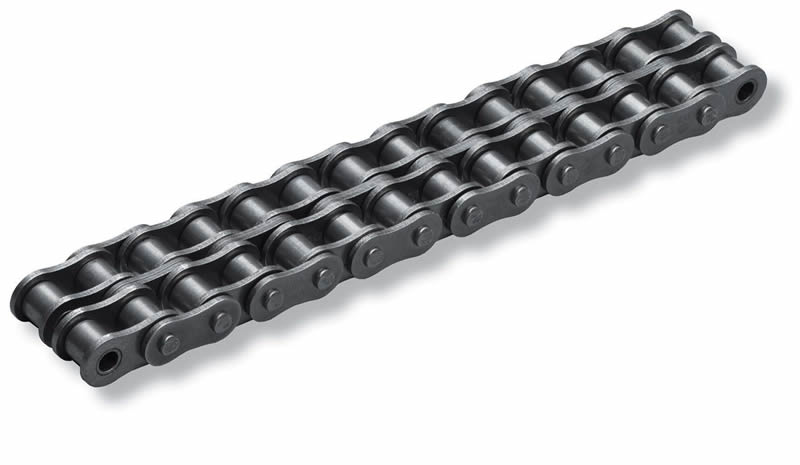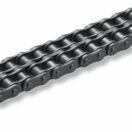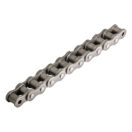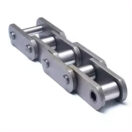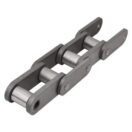The 16B-2 chain is a heavy-duty, double-strand roller chain used in various industrial applications. It is part of the British Standard series of roller chains, designed for tough, demanding environments where strength and durability are paramount. In industries that require efficient power transmission and reliable mechanical performance, the 16B-2 chain is an essential component. But what exactly is the 16B-2 chain, and in which industries is it used? This blog will explore the features, uses, and applications of the 16B-2 chain.
What is 16B-2 Chain?
The 16B-2 chain is a double-strand roller chain designed according to the ISO standards. It consists of interconnected links, including rollers, pins, and bushings, all assembled in a robust manner. The “2” in 16B-2 refers to the double-strand design, which means it has two rows of rollers, offering twice the strength compared to a single-strand chain. This configuration allows the chain to handle heavier loads and provides better distribution of the working forces across the chain.
The 16B-2 chain is widely used in industrial machinery, including conveyors, motors, and transmission systems. Due to its durable construction and high load-bearing capacity, it is a preferred choice in industries where machines are subjected to continuous use and heavy stress. This chain operates efficiently even in harsh environments, making it a versatile and reliable option for various applications.
What Are the Uses of 16B-2 Chain?
The 16B-2 chain has a broad range of applications across multiple industries. Its primary function is mechanical power transmission, but it can also be used in equipment that requires movement or force transfer between two points. Here are some key uses of the 16B-2 chain:
- Conveyor Systems: One of the most common uses of the 16B-2 chain is in conveyor belts, especially in manufacturing and production facilities. The chain helps in the smooth movement of products along the conveyor belt, allowing for efficient material handling.
- Agricultural Machinery: In agriculture, the 16B-2 chain is used in machinery such as harvesters, tractors, and other farming equipment. These machines require strong and reliable chains for moving parts and ensuring efficient operation in demanding field conditions.
- Automotive Industry: In automotive manufacturing plants, the 16B-2 chain is often used in assembly lines and power transmission systems. It helps in moving heavy components and in processes like engine assembly.
- Mining Equipment: Mining is another industry where the 16B-2 chain is used extensively. The chain’s high strength makes it ideal for the harsh, demanding environments found in mining operations, including conveyors, drilling equipment, and material transport systems.
These are just a few examples of how versatile and indispensable the 16B-2 chain is across various sectors.
Applications of 16B-2 Chain
The 16B-2 chain’s applications are numerous, thanks to its double-strand design that enhances durability and load-bearing capacity. Here are the primary industries that rely on the 16B-2 chain:
- Food and Beverage Industry: Conveyor belts in food production lines often use the 16B-2 chain to move products efficiently while maintaining hygiene standards. The chain is easy to clean and maintain, ensuring that it meets the stringent hygiene requirements of the food and beverage sector.
- Construction Industry: In construction, heavy machinery such as cranes, hoists, and drilling rigs use 16B-2 chains to handle heavy loads and perform demanding tasks. The chain’s ability to withstand extreme stress and weather conditions makes it a trusted choice in this industry.
- Textile Industry: Textile machinery also employs 16B-2 chains for the continuous movement of fabrics and other materials through various stages of production. The smooth operation of the chain helps in minimizing friction and wear, ensuring long-term performance.
What Materials Are 16B-2 Chains Made Of?
The 16B-2 chain is typically made of high-quality carbon steel or stainless steel, depending on the application. Carbon steel is favored for its strength and resistance to wear and tear, making it ideal for heavy-duty applications. For environments where the chain is exposed to moisture, chemicals, or extreme temperatures, stainless steel is used due to its superior resistance to corrosion and rust.
Both materials undergo heat treatment processes to enhance their durability and tensile strength, ensuring that the chain can withstand the demanding conditions of industrial operations.
In Which Industries Is 16B-2 Chain Used?
The 16B-2 chain is a highly versatile component, used in a wide range of industries. Some of the main sectors that benefit from this chain include:
- Manufacturing: In manufacturing plants, the 16B-2 chain is used in conveyor systems and mechanical processes where reliability and efficiency are critical.
- Energy Sector: Power plants and energy generation facilities use the 16B-2 chain for various applications, including turbines and other machinery that require high-load transmission.
- Packaging Industry: In packaging facilities, the 16B-2 chain is used to move products through different stages of the packaging process, from assembly to shipping.
How Is 16B-2 Chain Cleaned?
Regular maintenance is crucial for extending the life of the 16B-2 chain. Here’s how it can be cleaned and maintained:
- Debris Removal: Use a brush or compressed air to remove dirt and debris from the chain’s surface.
- Cleaning: Apply a degreaser or specialized chain cleaner to dissolve built-up grease and grime.
- Lubrication: After cleaning, ensure the chain is lubricated to reduce friction and wear during operation. Proper lubrication helps the chain move smoothly and increases its lifespan.
Installation of 16B-2 Chain
When installing the 16B-2 chain, it’s essential to follow these steps to ensure optimal performance:
- Alignment: Ensure the sprockets are aligned properly before installing the chain. Misalignment can lead to uneven wear and reduced efficiency.
- Tensioning: Adjust the tension so the chain is neither too tight nor too loose. Incorrect tension can cause premature wear or even damage the chain.
- Inspection: After installation, regularly inspect the chain for any signs of wear or damage to avoid breakdowns during operation.
The 16B-2 chain is a crucial component in many industrial applications, offering superior strength, durability, and versatility. Its use across multiple industries—from automotive to food production—underscores its importance in mechanical systems that require reliable power transmission. With proper maintenance and installation, the 16B-2 chain can offer long-lasting performance, making it a valuable asset in any industrial setting.

